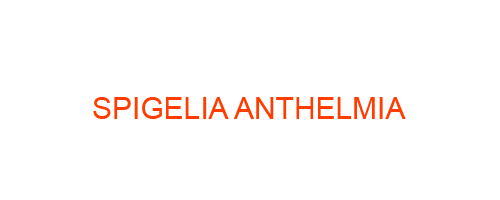Spigelia anthelmia is a homeopathic medicine derived from a plant commonly known as "Pinkroot" or "Indian Pink." It is primarily used for treating va
Spigelia anthelmia is a homeopathic medicine derived from a plant commonly known as “Pinkroot” or “Indian Pink.” It is primarily used for treating various conditions related to the head, eyes, and heart.
Properties and Preparation:
Spigelia anthelmia is prepared using the fresh, flowering plant of the same name. The plant is harvested during the flowering season, and the whole plant, including the roots, is used for the preparation.
After collection, the plant is macerated and mixed with alcohol to create a tincture. This tincture undergoes a series of dilutions to produce the final homeopathic remedy.
Symptoms treatment and materia medica:
Severe headache that starts at the back of the head and extends to the eyes, orbit, or temples. It may be throbbing, pulsating, or bursting in nature.
Eye symptoms include intense eye pain, especially in the left eye, as if it is being pulled backward into the socket.
Neuralgic pains, especially in the face, associated with dental issues or trigeminal neuralgia.
Intense chest pain, often described as constrictive or squeezing in nature, which may radiate to the left arm.
Palpitations and irregular heartbeats, worsened by lying on the left side.
Sensation of worms crawling or wriggling in various parts of the body.
Intense sensitivity to touch, particularly on the scalp or face.
Headaches triggered or worsened by motion, noise, touch, or light.
Pain in the eye socket or eyeballs, with a sensation of pressure or swelling.
Left-sided symptoms are often more prominent than right-sided symptoms.
Intense toothache or pain in the teeth, with sensitivity to cold air or liquids.
Vertigo or dizziness, with a tendency to fall to the left side.
Face flushed and hot, while the rest of the body remains cool.
Symptoms worsen with exposure to cold weather or cold winds.
Restlessness and anxiety, with a feeling of impending doom.
FAQs about Spigelia anthelmia:
Q: What potencies are available for Spigelia anthelmia?
A: It is available in various potencies, ranging from low (6X, 6C) to high (30C, 200C, and beyond). The appropriate potency depends on the individual’s symptoms and the guidance of a homeopathic practitioner.
Q: Can Spigelia anthelmia be used for self-treatment?
A: While homeopathic remedies are generally considered safe, it is advisable to consult a qualified homeopath for accurate diagnosis and appropriate treatment.
Q: How long should I take Spigelia anthelmia?
A: The duration of treatment varies depending on the severity and chronicity of the symptoms. A homeopath will provide guidance on the duration of treatment.
Q: Are there any known side effects?
A: Homeopathic remedies are highly diluted and generally safe to use. However, it is essential to follow the recommended dosage and consult a professional if any adverse effects occur.
Q: Can Spigelia anthelmia be used during pregnancy?
A: It is advisable to consult a homeopathic doctors before using any medication, including Spigelia anthelmia, during pregnancy.
Q: Can Spigelia anthelmia be taken alongside conventional medication?
A: Homeopathic remedies can often be safely used alongside conventional medication. However, it is crucial to inform your healthcare provider about all the medicines you are taking.
Q: How should Spigelia anthelmia be stored?
A: Homeopathic remedies should be stored in a cool, dry place, away from direct sunlight, strong odors, and electronic devices. They should be kept in their original packaging and out of reach of children.
Books References:
“A Concise Materia Medica of Homoeopathic Medicines” by S.R. Phatak
“A Clinical Materia Medica” by E.A. Farrington
“Keynotes and Red Line Symptoms of the Materia Medica” by Adolph von Lippe
“Boericke’s New Manual of Homeopathic Materia Medica with Repertory” by William Boericke
“The Materia Medica of the Nosodes” by Henry C. Allen
Please note that the information provided here is for informational purposes only and should not replace professional medical advice. It is always recommended to consult qualified homeopathic doctors for proper diagnosis, guidance, and individualized effective homeopathy treatment.

